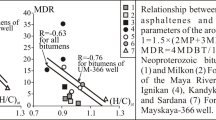Abstract
The composition and structure of bitumenoid asphaltenes of modern and fossil sediments has been studied using a set of instrumental methods (elemental and X-ray diffraction analyses, visible spectroscopy, NMR spectroscopy, EPR, electron microscopy), which made it possible to trace the evolution of the asphaltenes from their generation in diagenesis to degradation and transformation into kerogen under high catagenesis conditions. In diagenesis, protoasphaltenes are formed, which turn into asphaltenes as a result of catagenetic transformations. In apocatagenesis under severe thermobaric conditions at great depths, despite an overall decrease in bituminosity, the amount of hydrocarbons increases as a result of degradation of asphaltenes: molecules of organic compounds (occluded hydrocarbons) could be trapped and preserved in large cavities of the macromolecular structure of asphaltenes. Three generations of asphaltenes have been distinguished: early diagenetic (protoasphaltenes of modern sediments), mesocatagenetic (asphaltenes formed in the main catagenesis zone), and late catagenetic (asphaltenes produced under conditions of high temperatures and pressures).


Similar content being viewed by others
REFERENCES
H. Castex, Resines et asphaltenes: Revolution en function des types de matiereorganique et de leurenfouissement (Institut Francais du Petrole, 1977).
I. Rubinstein, C. Spyckerelle, and O. Strausz, Geochem. Cosmochem. Acta 43, 1 (1979).
S. R. Sergienko, Macromolecular Nonhydrocarbon Petroleum Components: Resins and Asphaltenes (Nauka, Moscow, 1979) [in Russian].
V. F. Kam’yanov, R. S. Aksenov, and V. I. Titov, Heteroatomic Components of Crude Oils (Nauka, Novosibirsk, 1983) [in Russian].
R. P. Philp and T. D. Gilbert, Geochem. Cosmochem. Acta 49, 1421 (1985).
G. N. Gordadze and Al. A. Petrov, Geol. Nefti Gaza, No. 3, 33 (1986).
I. V. Goncharov, Geochemistry of Western Siberia Oils (Nedra, Moscow, 1987) [in Russian].
G. N. Gordadze and G. V. Rusinova, in Proceedings of V International Conference on Oil and Gas Chemistry (Tomsk, 2003), p. 127 [in Russian].
A. K. Golovko, L. V. Gorbunova, and V. F. Kam’yanov, Geol. Geofiz. 51, 364 (2010).
Yu. M. Ganeeva, T. N. Yusupova, and G. V. Romanov, Usp. Khim. 80, 1035 (2011).
G. N. Gordadze, M. V. Giruts, V. N. Koshelev, and T. N. Yusupova, Pet. Chem. 55, 22 (2015).
L. R. Snowdon, J. K. Volkman, Z. Zhang, et al., Org. Geochem. 91, 3 (2016).
A. E. Kontorovich and L. S. Borisova, Geol. Geofiz., No. 5, 3 (1989).
A. E. Kontorovich and L. S. Borisova, Geokhimiya, No. 11, 1660 (1994).
L. S. Borisova, Geol. Geofiz. 45, 884 (2004).
L. S. Borisova, Geol. Nefti Gaza, No. 6, 75 (2016).
A. E. Kontorovich, L. S. Borisova, and V. N. Melenevskii, Geokhimiya, No. 10, 1423 (1987).
A. E. Kontorovich, V. P. Danilova, A. N. Fomin, et al., Izv. TPU, Geol. Razrab. Neft. Gaz. Mestorozhd. 305 (8), 45 (2002).
L. S. Borisova, in Lithological and Geochemical Bases of Petroleum Potential Forecast (VNIGRI, St. Petersburg, 2008), p. 93 [in Russian].
V. A. Kashirtsev, Geol. Geofiz., No. 8, 1211 (2018).
L. S. Borisova, Geol. Geofiz. 58, 366 (2017).
Modern Analytical Methods in Organic Geochemistry, Ed. by A. E. Kontorovich (SNIIGGiMS, Novosibirsk, 1973) [in Russian].
A. E. Kontorovich, V. P. Danilova, and A. S. Fomichev, Geochemistry of Bitumenoids in Subsurface Waters of Western Siberia Oil-and-Gas Basin (SNIIGGiMS, Novosibirsk, 1976), Issue 231, p. 3 [in Russian].
L. S. Borisova and A. E. Kontorovich, Guidelines for the Study of Asphaltenes for Source Rocks Diagnostics and Quantitative Assessment of the Prospects of Oil and Gas (SNIIGGiMS, Novosibirsk, 1991) [in Russian].
L. S. Borisova, Introduction to Geochemistry of Macromolecular Petroleum Components (NGU, Novosibirsk, 2012) [in Russian].
A. E. Kontorovich, Geochemical Methods for Quantitative Assessment of the Oil and Gas Potential (Nedra, Moscow, 1976) [in Russian].
B. P. Tissot and D. H. Welte, Petroleum Formation and Occurrence (Springer, Berlin, 1978).
L. S. Borisova, A. E. Kontorovich, and A. S. Fomichev, Advances in Organic Geochemistry, Ed. by A. E. Kontorovich (OIT INGG SO RAN, Novosibirsk, 2010), p. 60 [in Russian].
O. A. Radchenko and L. S. Sheshina, Tr. VNIGRI, No. 1, 274 (1955).
M. M. Kolganova and A. E. Kontorovich, Geol. Neftegaz. Raionov Zap.-Sib. Nizm.: Tr. SNIIGGiMS, No. 47, 184 (1966).
L. S. Borisova, Yu. G. Gladkikh, and M. M. Gubina, in Modern Methods for Determination of Metals in Crude Oils, Bitumens, and Their Processing Products (Leningrad, 1991), p. 15 [in Russian].
M. M. Gubina, in Organic Geochemistry of Source Rocks of Western Siberia (SO RAN, Novosibirsk, 1999), p. 144 [in Russian].
A. E. Kontorovich, Essays of Naphthidogenesis Theory (SO RAN, Novosibirsk, 2004) [in Russian].
E. M. Galimov and L. A. Kodina, Organic Matter and Gases in Sedimentary Strata of the World Ocean Bottom (Nauka, Moscow, 1982) [in Russian].
V. S. Veselovskii, Fossil Fuel Testing (Gos. Izd. Geologicheskoi Literatury, Moscow, 1951) [in Russian].
T. G. Chernova and E. P. Shishenina, Geokhimiya, No. 10, 1526 (1979).
I. D. Polyakova, G. Ch. Borukaev, G. N. Perozio, and M. F. Sokolova, Dokl. Akad. Nauk 345, 236 (1995).
A. E. Kontorovich, V. P. Danilova, and V. M. Dindoin, Dokl. Akad. Nauk SSSR, Ser. Geol. 209, 1431 (1973).
A. E. Kontorovich, I. D. Polyakova, M. M. Kolganova, and E. I. Soboleva, Sov. Geol., No. 7, 26 (1988).
Guidelines for the Use of the Pyrolysis Method in Organic Geochemistry, Ed. by A. E. Kontorovich (SNIIGiMS, Novosibirsk, 1985) [in Russian].
Funding
This work was supported by the Russian Foundation for Basic Research, project no. 18-05-00786, and the Federal Basic Research Program, project no. 0331-2019-0022.
Author information
Authors and Affiliations
Corresponding author
Additional information
Translated by S. Zatonsky
Rights and permissions
About this article
Cite this article
Borisova, L.S. The Origin of Asphaltenes and Main Trends in Evolution of Their Composition During Lithogenesis. Pet. Chem. 59, 1118–1123 (2019). https://doi.org/10.1134/S0965544119100037
Received:
Revised:
Accepted:
Published:
Issue Date:
DOI: https://doi.org/10.1134/S0965544119100037




